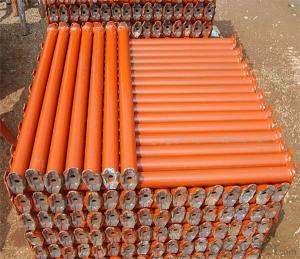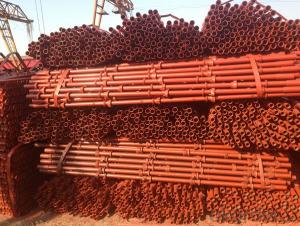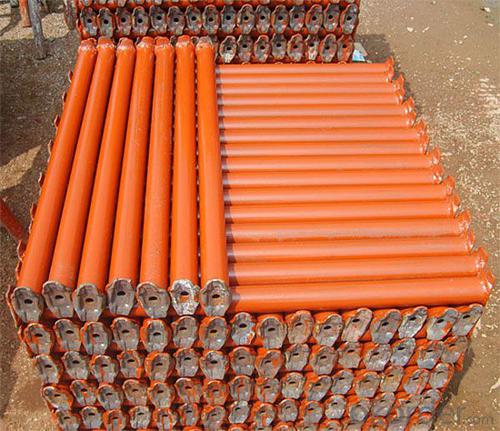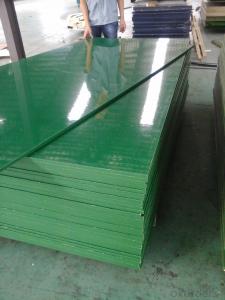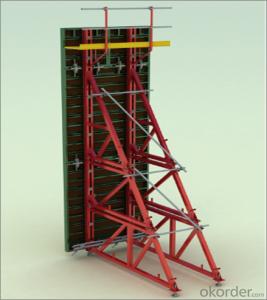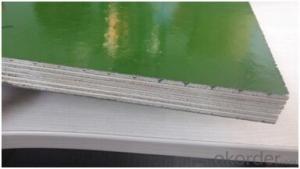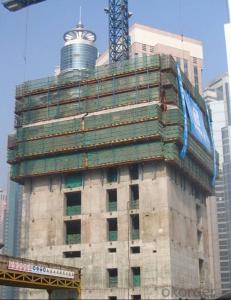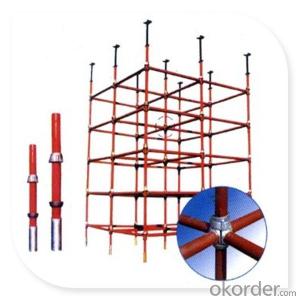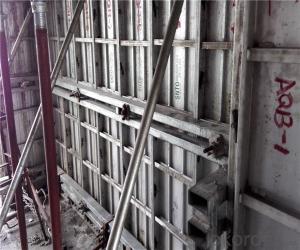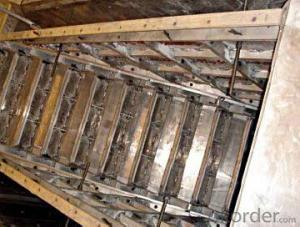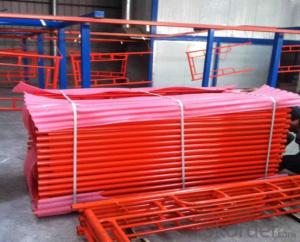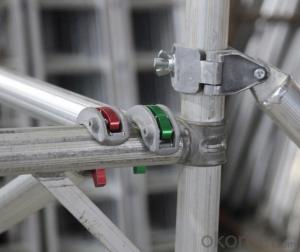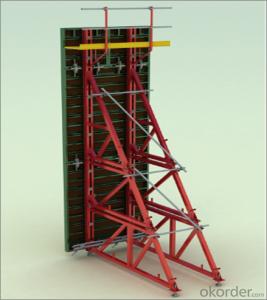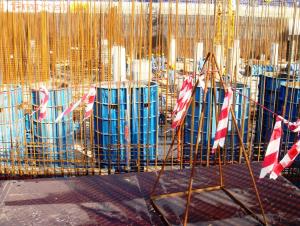Wedge Lock Scaffolding Formwork Aluminum Stair Scaffolding Cnbm
- Loading Port:
- Tianjin
- Payment Terms:
- TT OR LC
- Min Order Qty:
- 10000 set
- Supply Capability:
- 50000 set/month
OKorder Service Pledge
OKorder Financial Service
You Might Also Like
Wedge Lock Scaffolding Formwork Aluminum Stair Scaffolding CNBM
Frame Scaffolding Systems Formwork Bs Standard Scaffolding Tube With Low Price
Developing with new technology materials, steel formworks is no longer a must in construction concrete process. More and more buildings are established with plastic formworks. And workers love this new formworks much more.
The advantages of plastic formworks:
1.First of all--light
Yes it is the first advantage of plastic formwork. It wins the great praise of both contractors and workers.
The biggest panel is 120×1500px,weights 10.5kg only. It can be lift and set up by one person easily, which means there is no need for cranes on site.Saves a lot of cost and time.
2.Easy set up
Different size of panels can firmly locked by simply turn the special handles to 90 degree. The Panels has rib on the back, which makes the system need not traditional wood blocks and nails. The panels have holes to fit tie rod, guarantee the strength of the whole system.
3.Modularity
Modular formworks composed by different size of panels,the main item is 120×1500px panel,which is used for the large area of walls and slabs. There are also small size of panels like 10×1500px,20×1500pxcm,25×1500px,inner corner 20×20×1500px and outer corner 10×5×1500px.Due to the variety of panel size, the system can form almost all size walls 120×1500px panel of multiply by 125px. The material of modular formwork is PC-ABS mixed with special glass fibers which enable panels to hold high pressures.
4.Strength
The handles are made by high strength Nilon, each panel locked by at least 4 handles, which makes the whole system strong enough to pour 1000px walls.
5.Environment friendly
The system needs no cut and nail due to the variety size. Also it needs nearly no wood. The material can be recycled after broken, so it will not pollute the environment.
6.Consequent
Concrete does not stick to plastic formwork, thus the panels need no oil before using, and can be cleaned simply by water. The surface of the wall which build by modular formwork is smooth and without rework.
Wedge Lock Scaffolding Formwork Aluminum Stair Scaffolding CNBM
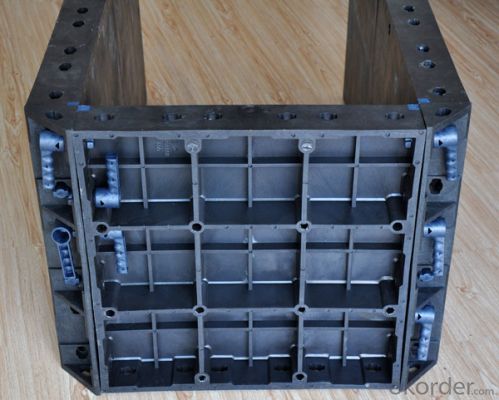
Wedge Lock Scaffolding Formwork Aluminum Stair Scaffolding CNBM
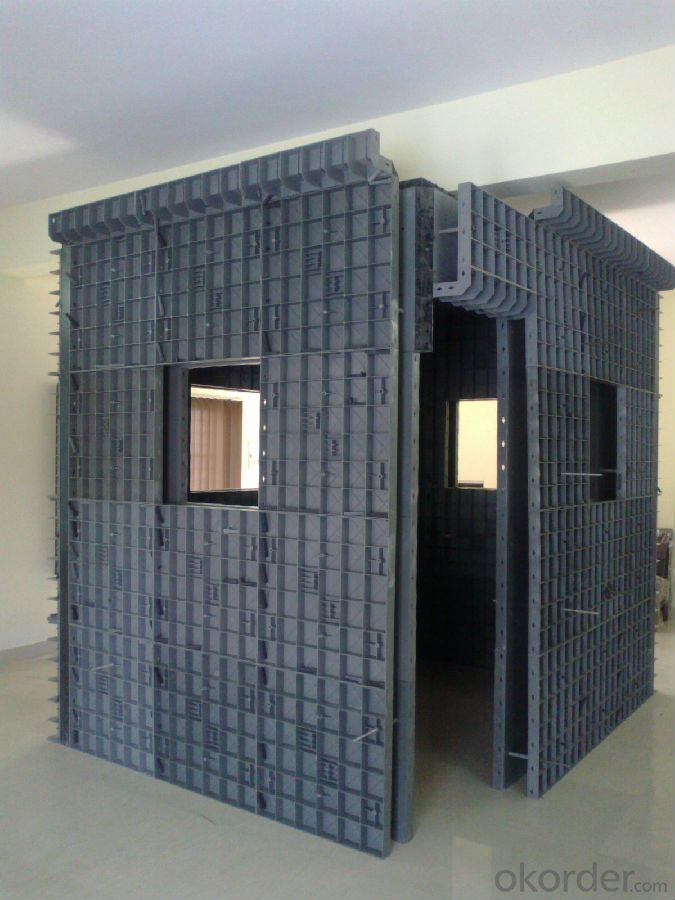
Wedge Lock Scaffolding Formwork Aluminum Stair Scaffolding CNBM
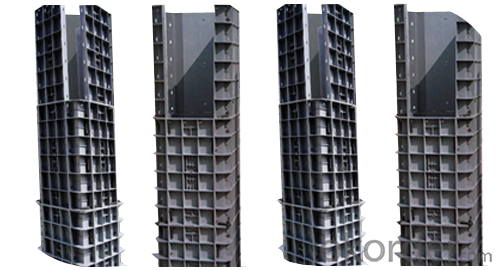
Advantage
* Good loading capacity
* Easy to assemble and dismantle
* Stable and durable thanks to its structual design & automatic welding quality
* Customized solution helps you work safe, save cost and convenient
* Excellent quality for formwork & scaffolding with wide choices
Wedge Lock Scaffolding Formwork Aluminum Stair Scaffolding CNBM
Packing
in bulk or in bundle, or as requested
Shipping
15-20 Days.
Normally small orders, it needs just 15-20 business days to the port. For goods with stock, it would be even shoter.
Wedge Lock Scaffolding Formwork Aluminum Stair Scaffolding CNBM
Other scaffolding & formwork products:
(1) Scaffolding System:
Including Ringlock Scaffolding System and accessories; Cuplock Scaffolding System and accessories; Kwikstage Scaffolding System and accessories; Haki Scaffolding System and accessories;
(2) Scaffolding Frame & Accessories:
Including Walk Through Frame Scaffolding; Ladder Frame Scaffolding; Accessories; we also can make scaffolding according to your samples or drawings.
(3) Scaffolding Couplers/Clamps:
We can produce all kinds of forged and pressed couplers, including British type couplers, American type couplers, German type couplers, Italian type couplers ,fence couplers, BRC coplers and so on. We also can produce according to your drawings or samples.
(4) Formwork System Scaffolding & Accessories:
Light Duty Shoring prop and Heavy Duty Shoring Prop; Wing nuts and Tie rods; RASTO clamp and so on.
FAQ Wedge Lock Scaffolding Formwork Aluminum Stair Scaffolding CNBM
Why Us?
We are one of the Top 500 in the world, largest construction materials supplier in China. Also we are a state-owned company and respond to every customer with large and also small orders.
We own professional manufacturers with powerful producing capacity.
Extensive and comprehensive quality control system
Excellent products with competitive prices.
Efficient services in pre and after sale.
Full energy with affluent experience team.
- Q: What are the different types of formwork hinges used with steel frame formwork systems?
- There are several types of formwork hinges that are commonly used with steel frame formwork systems. These hinges are designed to provide flexibility and ease of use when constructing concrete structures. Here are some of the different types of formwork hinges used with steel frame formwork systems: 1. Fixed Hinges: Fixed hinges are the most basic type of formwork hinge used in steel frame systems. These hinges are fixed at a specific angle and cannot be adjusted once they are installed. They are typically used for straight walls or columns where there is no need for angular adjustments. 2. Adjustable Hinges: Adjustable hinges provide the flexibility to adjust the angle of the formwork. These hinges have a locking mechanism that allows the user to set the desired angle and secure it in place. They are commonly used for walls or columns that require angular adjustments. 3. Sliding Hinges: Sliding hinges are used when there is a need to move the formwork horizontally or vertically. These hinges have a sliding mechanism that allows the formwork to be adjusted to the desired position. They are particularly useful when constructing complex structures or when adjustments need to be made during the construction process. 4. Swivel Hinges: Swivel hinges are used when there is a need to rotate the formwork. These hinges have a swiveling mechanism that allows the formwork to be rotated to the desired position. They are commonly used when constructing curved walls or structures that require a specific curvature. 5. Combination Hinges: Combination hinges combine the features of adjustable, sliding, and swivel hinges. These hinges provide the maximum flexibility and adjustability, allowing the formwork to be set at any desired angle, position, or rotation. They are commonly used for complex structures where multiple adjustments may be required. Overall, these different types of formwork hinges provide the necessary flexibility and adaptability to meet the varying requirements of steel frame formwork systems. They enable construction professionals to construct concrete structures accurately and efficiently, while ensuring the highest level of quality and safety.
- Q: What are the different types of formwork pins used with steel frame formwork systems?
- There are several different types of formwork pins that are commonly used with steel frame formwork systems. These pins are used to secure the formwork panels and ensure stability during the concrete pouring process. 1. Wedge pins: These are the most commonly used formwork pins. They are made of steel and have a wedge shape at one end. The wedge is inserted into the slot on the formwork panel, and the pin is then driven into place using a hammer. The wedge shape helps to secure the formwork panels tightly, preventing any movement during the concrete pouring process. 2. Straight pins: Straight pins are also made of steel and are used in a similar way as wedge pins. However, instead of a wedge shape, these pins have a straight, cylindrical shape. They are inserted into pre-drilled holes in the formwork panels and secured in place using a hammer. Straight pins are often used in situations where a wedge pin cannot be easily inserted or where additional reinforcement is needed. 3. Snap ties: These are a type of formwork pin that consists of a metal rod with a button-like head at one end. The rod is inserted through the formwork panels, and the head is then snapped into place, securing the panels together. Snap ties are commonly used in formwork systems where quick assembly and disassembly are required. 4. Coil ties: Coil ties are another type of formwork pin that are used to secure formwork panels together. They consist of a metal rod with a spiral coil at one end. The coil is inserted into pre-drilled holes in the formwork panels, and the rod is then twisted to secure the panels tightly. Coil ties provide a strong and secure connection between the formwork panels. 5. Flat ties: Flat ties are formwork pins that are used to secure formwork panels together in a flat orientation. They consist of a metal rod with a flat plate-like head at one end. The rod is inserted through the formwork panels, and the head is then twisted to secure the panels tightly. Flat ties are commonly used in wall formwork systems. Overall, the different types of formwork pins used with steel frame formwork systems provide a variety of options to ensure that the formwork panels are securely connected and stable during the concrete pouring process.
- Q: How does steel frame formwork affect the overall sustainability goals of a construction project?
- Steel frame formwork can significantly contribute to the overall sustainability goals of a construction project. Firstly, steel is a highly durable and long-lasting material, ensuring that the formwork can be used repeatedly, reducing the need for frequent replacements and minimizing waste generation. Additionally, steel is recyclable, allowing for the formwork to be repurposed or recycled at the end of its lifecycle, thus reducing the environmental impact. Moreover, steel frame formwork provides structural stability and strength, enabling the construction of more efficient and sustainable buildings. By utilizing steel frame formwork, construction projects can achieve their sustainability goals by reducing waste, conserving resources, and creating more environmentally friendly structures.
- Q: What are the different types of connections used in steel frame formwork systems?
- There are two main types of connections used in steel frame formwork systems: bolted connections and welded connections. Bolted connections involve the use of nuts and bolts to secure the different components together, providing flexibility in assembly and disassembly. Welded connections, on the other hand, involve fusing the structural elements using heat, resulting in a permanent and strong connection. Both types of connections have their advantages and disadvantages depending on the specific requirements of the construction project.
- Q: Does steel frame formwork require any specific curing methods?
- Steel frame formwork does not require any specific curing methods. Unlike traditional formwork materials such as wood or plywood, steel frame formwork is not affected by moisture or temperature variations. It is a durable and non-absorbent material that does not require any special curing techniques. Once the concrete is poured into the formwork, it will naturally cure and harden on its own, regardless of the type of formwork used. However, it is important to follow standard concrete curing practices, such as providing adequate moisture and temperature control, to ensure proper curing and achieve the desired strength and durability of the final concrete structure.
- Q: What are the different finishes available for steel frame formwork panels?
- Steel frame formwork panels can be finished in various ways to meet the specific needs of a construction project. Some commonly used finishes include: 1. Smooth Surface: The steel frame formwork panels are left with a smooth finish, which is ideal for projects where a sleek concrete surface is desired. 2. Textured Surface: In certain cases, a textured finish is preferred to enhance the adhesion between the concrete and the formwork. This can be achieved by adding texture to the surface of the panels. 3. Powder Coating: Powder coating is a popular choice for finishing steel frame formwork panels. It involves applying a dry powder to the surface, which is then heated to create a durable and protective coating. Powder coating offers a smooth and even finish, as well as enhanced resistance against corrosion. 4. Galvanization: Galvanizing is a process that involves applying a protective layer of zinc to the surface of the panels. This not only provides corrosion resistance but also improves overall durability. 5. Paint Coating: Another option for finishing steel frame formwork panels is to apply a liquid paint coating. This provides both aesthetic appeal and protection against corrosion. When selecting a finish for steel frame formwork panels, it is important to consider factors such as durability, corrosion resistance, and aesthetic requirements. Consulting with a construction professional or engineer can help determine the most suitable finish for a specific project.
- Q: Can steel frame formwork be used for both internal and external concrete walls?
- Yes, steel frame formwork can be used for both internal and external concrete walls. The steel frame provides strength and stability, making it suitable for various construction applications. Additionally, the formwork can be easily adjusted and reused, making it a cost-effective solution for both internal and external walls.
- Q: In the process of construction of reinforced concrete frame structure, the main contents of the quality inspection and monitoring of formwork engineering
- The specifications, quality and fastening conditions of all kinds of connecting pieces and supporting parts (the use of torque wrench for fasteners); 3, the overall stability of the supporting points and the combined steel formwork;
- Q: What are the different methods of concrete pouring with steel frame formwork?
- There are several different methods of concrete pouring with steel frame formwork that can be used depending on the specific project requirements. 1. Traditional Pouring: This is the most commonly used method where the steel frame formwork is assembled on-site and concrete is poured directly into the formwork. The concrete is then allowed to cure and harden before the formwork is removed. 2. Slip Forming: This method is often used for tall structures such as skyscrapers or chimneys. The steel frame formwork is continuously moved upward as the concrete is poured, allowing for a continuous pour without any joints. This method requires specialized equipment and skilled workers to ensure a smooth and even finish. 3. Jump Forming: Similar to slip forming, jump forming is used for tall structures but involves pouring concrete in sections or "jumps". The steel frame formwork is lifted to the next section after each jump, allowing for a continuous pour. This method is often used for building cores or elevator shafts. 4. Pre-cast Panels: In this method, pre-cast concrete panels are manufactured off-site and then transported to the construction site. The steel frame formwork is used to hold the panels in place while they are connected and sealed. This method is often used for fast-track construction projects where time is of the essence. 5. Tunnel Forming: This method is commonly used for constructing walls and slabs in buildings with repetitive floor plans, such as residential or commercial structures. The steel frame formwork is assembled to create a tunnel-like structure, and concrete is poured inside. This method allows for a rapid construction process as multiple floors can be poured simultaneously. Each of these methods has its own advantages and considerations, and the choice of method will depend on factors such as project requirements, timeline, budget, and the expertise of the construction team.
- Q: What are the different types of formwork connections used with steel frame formwork?
- Steel frame formwork can be used with several different types of connections to securely join the formwork panels together during the concrete pouring process. Some commonly used connections include the following: 1. Wedge connections: Steel wedges are inserted into pre-drilled holes in the formwork panels and tightened to hold the panels securely. 2. Bolted connections: Bolts, nuts, and washers are used to join the formwork panels. Holes are drilled in the panels and bolts are inserted through them, with nuts and washers tightened to secure the panels. 3. Pin and wedges connections: Steel pins are inserted into holes in the formwork panels, and wedges are driven into slots on the pins to hold the panels together. 4. Clamping connections: Clamps or clamping devices are used to join the formwork panels. These clamps are tightened around the panels, applying pressure for a secure connection. 5. Magnetic connections: Magnets embedded within the formwork panels create a strong bond between them, eliminating the need for additional connectors. 6. Hook and loop connections: Straps with hook and loop fasteners are used to join the formwork panels. These straps are wrapped around the panels, providing a secure connection. The choice of formwork connection depends on factors such as project requirements, the formwork system being used, and the desired level of ease and speed of assembly. Each type of connection has its own advantages and disadvantages.
Send your message to us
Wedge Lock Scaffolding Formwork Aluminum Stair Scaffolding Cnbm
- Loading Port:
- Tianjin
- Payment Terms:
- TT OR LC
- Min Order Qty:
- 10000 set
- Supply Capability:
- 50000 set/month
OKorder Service Pledge
OKorder Financial Service
Similar products
Hot products
Hot Searches
Related keywords
